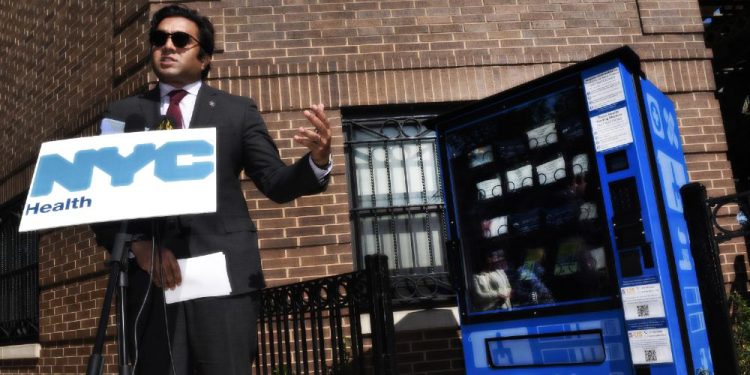Should we just go ahead and give free needles and free crack pipes to everyone in America? After all, if New York City and Los Angeles plan to solve their raging drug problems by handing out free drug paraphernalia to addicts, perhaps we can solve our nationwide drug crisis the same way.
Let’s make the entire country one big “harm reduction zone” and then everything will return to normal, right? Unfortunately, that is not the way that the real world works. If you give addicts what they need, they will thank you. And then they will go ahead and do drugs right in front of you.
I don’t know why politicians can’t understand that this sort of approach is doing far more harm than good.
On Monday, New York City unveiled their new vending machines which will allow addicts to get drug paraphernalia for free…
Big Apple officials unveiled a street vending machine Monday that covers it all when it comes to catering to drug-users, offering free handy paraphernalia such as crack pipes and lip balm — and also Narcan for overdoses.
The vending machine, one of four set to be placed in some of the city’s most drug-infested neighborhoods, swaps out what would be more typical offerings such as candy bars and potato chips for the drug-related freebies to try to combat the surge in overdoses in the five boroughs, city Health Department bigs said.
The pipes that come with the “safer smoking” kits can be used to smoke both crack and crystal meth.
At least they are versatile.
Needless to say, addicts are quite enthusiastic about the new program. In fact, the first vending machine was completely empty less than 24 hours after it was unveiled…
New York City’s first public health vending machine giving out free crack pipes, condoms and Narcan, an overdose-reversing drug, was already empty less than 24 hours after being unveiled by officials.
But eager city officials determined to keep residents in rich supply of clean drug apparatus were quick to revisit the site on Tuesday afternoon with more.
Elan Quashie, the Opioid Overdose Program Director at Services for the Under Served, said: ‘We’re going to restock every day. Probably multiple times a day.’
Are they really planning to restock the machine “multiple times a day”?
I find that hard to believe, because I have never seen such a high level of customer service from government bureaucrats anywhere that I have ever lived.
It turns out that Los Angeles County has a similar program.
But instead of vending machines, social workers actually go around and give “supply kits” to addicts that contain “glass pipes, needles, fentanyl test strips and naloxone”…
Los Angeles County’s Harm Reduction Program has drawn attention for its controversial approach to tackling the fentanyl epidemic.
As part of the program, outreach workers distribute harm reduction supply kits containing glass pipes, needles, fentanyl test strips and naloxone, a drug used to counteract an overdose.
The program comes at a significant cost to taxpayers, with the county spending over $31 million this year, a sharp increase from the previous year’s approximately $5 million expenditure.
That sounds like quite a good deal for the addicts.
But what about the rest of us?
In order to fund their addictions, the addicts have to steal stuff.
Retailers have become a primary target, and a new bill that has been going through the California legislature would actually “ban retail staff from stopping thieves stealing from their stores”…
Lawmakers in California are hoping to push through controversial legislation that would ban retail staff from stopping thieves stealing from their stores.
Senate Bill 553, which was submitted by State Senator Dave Cortese, has been passed by the State Senate and will now progress to policy committees in the State Assembly. Cortese hopes the proposed law will prevent workplace violence and protect staff from being forced by their employers to step-in during robberies. But some store bosses are furious about the plans, with the California Retailers Association mocking the move as an open invitation for thieves “to come in and steal.”
Seriously?
It is already ridiculously easy to shoplift in California, and the politicians want to make it even easier?
Are they insane?
The theory is that there will be fewer violent confrontations if the crooks are just allowed to do whatever they want.
Of course the overworked and overwhelmed police rarely get there in time either.
And the few thieves that are caught are let go with just a slap on the wrist as long as they keep their shoplifting under a certain dollar amount.
California is getting dangerously close to legalizing shoplifting, and I am sure that is what many of the politicians would like to see.
But if you use the wrong pronoun or make an “offensive” statement on social media, that could get you into really big trouble.
All over the western world, authorities are really cracking down on such “crimes”. In fact, a new law in Australia would put people in prison for up to three years for making “offensive” statements on social media…
A sweeping law could see Australians jailed for three years for posting what’s deemed ‘offensive’ on Facebook in an attempt to protect minority groups.
Queensland’s Labor government has introduced a bill that would dramatically increase the maximum prison sentence for racist, anti-gay, anti-trans or seriously bigoted statements.
Making such statements already carry a maximum six-month jail term, but that would be increased to three years under the new bill.
This is where the entire western world is going.
Drug addicts, thieves and violent criminals are now considered to be “victims” that must be treated with compassion, but those that express “offensive” views on social media are considered to be a massive threat to “democracy” and must be dealt with ruthlessly.
We live in a society that has been completely turned upside down, and it is only going to get worse in the years ahead.
Once upon a time we were the greatest society on the entire planet, but now we have become a bad joke to the rest of the world.
Is there still any hope that we could turn things around even at this late hour?
Michael’s new book entitled “End Times” is now available in paperback and for the Kindle on Amazon.com, and you can check out his new Substack newsletter right here.
Article cross-posted from End of the American Dream.






